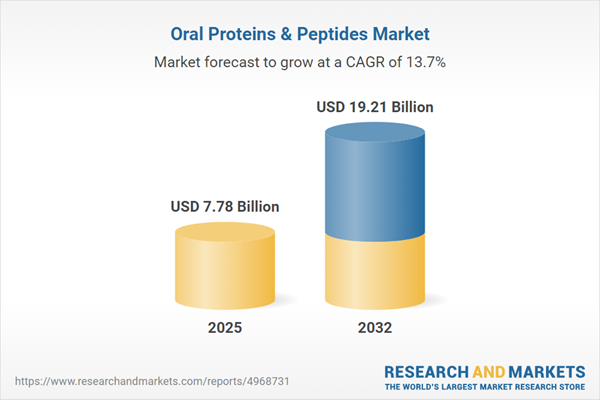Speak directly to the analyst to clarify any post sales queries you may have.
The oral proteins and peptides market is undergoing significant transformation, driven by advances in delivery technologies, shifting regulatory frameworks, and evolving industry strategies. Senior decision-makers need to stay informed on these trends to navigate challenges and capitalize on emerging opportunities in this dynamic sector.
Market Snapshot: Oral Proteins & Peptides Market Size and Growth
The Oral Proteins & Peptides Market grew from USD 6.89 billion in 2024 to USD 7.78 billion in 2025. It is expected to continue growing at a CAGR of 13.67%, reaching USD 19.21 billion by 2032.
Scope & Segmentation
This research delivers a comprehensive perspective on the oral proteins and peptides industry, spanning product segments, formulation technologies, development stages, applications, end-users, and geographical regions. The analysis includes:
- Product Type: Insulin-based proteins (combination insulin products, long-acting insulin analogues, rapid-acting insulin analogues, recombinant human insulin), peptide therapeutics (calcitonin-based therapies, glucagon-like peptide-1 receptor agonists, vasopressin analogs).
- Formulation: Capsule formulations, liquid formulations, powder formulations, tablet formulations.
- Development Stage: Phase I & II clinical trials, Phase III clinical trials, post-market surveillance, preclinical studies.
- Application: Cancer treatment, cardiovascular diseases, diabetes management, hormonal disorders.
- End-User: Home care settings, hospitals and clinics, research laboratories, specialty clinics.
- Geographical Coverage: Americas (United States, Canada, Mexico, Brazil, Argentina, Chile, Colombia, Peru), Europe, Middle East & Africa (United Kingdom, Germany, France, Russia, Italy, Spain, Netherlands, Sweden, Poland, Switzerland, United Arab Emirates, Saudi Arabia, Qatar, Turkey, Israel, South Africa, Nigeria, Egypt, Kenya), Asia-Pacific (China, India, Japan, Australia, South Korea, Indonesia, Thailand, Malaysia, Singapore, Taiwan).
- Leading Companies: Profiled organizations include AbbVie Inc., Amgen Inc., Amryt Pharma plc, Astellas Pharma Inc., AstraZeneca PLC, Biocon Limited, Boehringer Ingelheim International GmbH, among others.
Key Takeaways for Decision-Makers
- Market leaders are adopting advanced formulation and carrier systems to address challenges such as enzymatic degradation and low mucosal permeability, thereby improving oral delivery success rates.
- Strategic collaborations, mergers, and acquisitions are central for companies expanding their technology portfolios and accelerating time to market for new oral peptide therapies.
- Regulatory evolution, including adaptive approval pathways, enables faster initiation of clinical programs, especially for breakthrough candidates and therapies targeting unmet medical needs.
- Technological advances like permeation enhancers, nanocarriers, and microencapsulation are supporting the development of oral therapeutics that improve patient adherence and can reduce dosing frequency.
- Regional growth is underpinned by factors such as healthcare infrastructure, local regulatory environments, and collaborative partnerships between multinational and domestic players supporting technology transfer and localized production.
Tariff Impact: Navigating New Cost Structures
Recent United States tariffs on imported ingredients and excipients have altered cost structures, prompting manufacturers to reexamine sourcing strategies. Many are partnering with domestic suppliers, pursuing free trade agreements for critical components, and investing in local manufacturing to minimize exposure to tariff-related disruptions. Strengthened supply chain resilience and compliance adaptation now play a growing role in operational decision-making for stakeholders across the oral proteins and peptides sector.
Methodology & Data Sources
The report’s findings are derived through a balanced combination of secondary research—analyzing industry literature, patents, regulations, and trade sources—and primary interviews with experts in science, regulatory affairs, and supply chain management. Data triangulation and rigorous quality checks validate the analysis and ensure reliability for strategic planning.
Why This Oral Proteins & Peptides Market Report Matters
- Supports decision-making with detailed insights on critical trends, segmentation, and regional dynamics.
- Enables benchmarking of company strategies, technology adoption, and response to regulatory and trade developments.
- Equips stakeholders with actionable recommendations for investment, partnership, and expansion planning in a competitive market environment.
Conclusion
The oral proteins and peptides market is advancing through the interplay of technological innovation, evolving regulatory systems, and supply chain adaptation. Informed, agile strategies will position organizations to seize emerging opportunities and sustain growth in this high-potential field.
Additional Product Information:
- Purchase of this report includes 1 year online access with quarterly updates.
- This report can be updated on request. Please contact our Customer Experience team using the Ask a Question widget on our website.
Table of Contents
3. Executive Summary
4. Market Overview
7. Cumulative Impact of Artificial Intelligence 2025
Companies Mentioned
The companies profiled in this Oral Proteins & Peptides market report include:- AbbVie Inc.
- Amgen Inc.
- Amryt Pharma plc
- Astellas Pharma Inc.
- AstraZeneca PLC
- Biocon Limited
- Boehringer Ingelheim International GmbH
- Catalent, Inc.
- Entera Bio Ltd. by DNA Biomedical Solutions
- F. Hoffmann-La Roche AG
- Hunan Huateng Pharmaceutical Co., Ltd. by Tasly Capital
- Johnson & Johnson Services, Inc.
- Merck KGaA
- Novartis AG
- Novo Nordisk A/S
- Oramed Pharmaceuticals Inc.
- PeptiDream Inc.
- Pfizer, Inc.
- Protagonist Therapeutics, Inc.
- Proxima Concepts Limited
- Rani Therapeutics, LLC
- Sanofi S.A.
- Tarsa Therapeutics, Inc.
- Teva Pharmaceutical Industries Ltd.
- Zealand Pharma A/S
Table Information
| Report Attribute | Details |
|---|---|
| No. of Pages | 190 |
| Published | November 2025 |
| Forecast Period | 2025 - 2032 |
| Estimated Market Value ( USD | $ 7.78 Billion |
| Forecasted Market Value ( USD | $ 19.21 Billion |
| Compound Annual Growth Rate | 13.6% |
| Regions Covered | Global |
| No. of Companies Mentioned | 26 |









